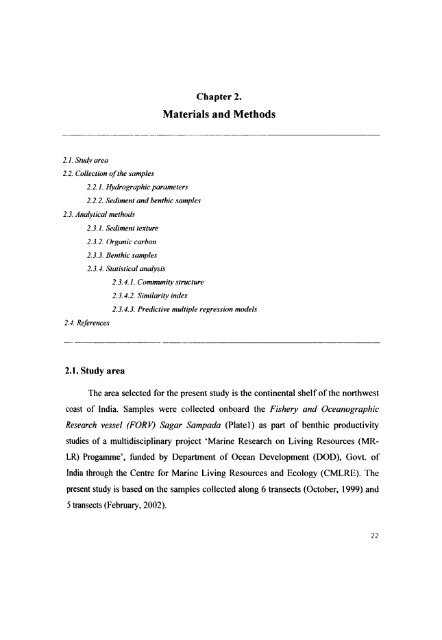- Page 2 and 3: Certificate I hereby certify that t
- Page 4 and 5: Contents Page No. Chapter 1. Introd
- Page 6: the bottom. Ekman (1935) described
- Page 9 and 10: wonns are the most abundant group a
- Page 11 and 12: leadership of Sir James Clark Ross,
- Page 13 and 14: Ansari et al., (1977b) carried out
- Page 15 and 16: Gopalakrishnan and Nair (1998) cond
- Page 17 and 18: Major objectives:- 1. To understand
- Page 19 and 20: CMFRI (Central Marine Fisheries Res
- Page 21 and 22: Joydas, T.V., Damodaran, R., 2001.
- Page 23 and 24: monitoring committee (Atlantic Mari
- Page 25: Vizakat Lathika, I-Iarkantra, S. N.
- Page 29 and 30: 2. 2. 2. 1. Macrobenthos After sub
- Page 32 and 33: 2.3.4.1 Community structure PRIMER
- Page 34: 2.4. References Bray, J. R., Curtis
- Page 37: Plate1 Plate 2 Plate 3 Plate 4
- Page 40 and 41: The distribution of oxygen in the o
- Page 42 and 43: The continental shelf along the wes
- Page 45 and 46: was observed upto 75 m and then dec
- Page 47 and 48: Monnugao and Ratnagiri and along ot
- Page 49 and 50: the eastern Indian Ocean into the w
- Page 51 and 52: 3.4. References Bhattathiri, P. M.
- Page 53: Depths Temperature Salinity Dissolv
- Page 61 and 62: 4.1. Sediment texture 4.1.1. Introd
- Page 63 and 64: distribution off Mumbai region upto
- Page 67 and 68: in deeper depths no change has take
- Page 69 and 70: deposition of sediments from differ
- Page 71: food supply and the consumption of
- Page 74 and 75: during pre-monsoon) followed by 75
- Page 76 and 77:
Present study also showed high OM i
- Page 78 and 79:
4.3. References Anon, 1997. Benthic
- Page 80 and 81:
Nair, R. R., Hashimi, N. H., Kidwai
- Page 82:
ZoBell, C. E., Stadler, J., 1940. T
- Page 88:
100 80 '" 60 • 40 2 • G R M V T
- Page 95 and 96:
5.1. Introduction 5.2. Results 5.2.
- Page 97:
espectively. Parulekar and Wagh (19
- Page 100 and 101:
more only at stations off Ratnagiri
- Page 102 and 103:
elaatively higher average density i
- Page 105 and 106:
that nematodes contributed 27.3 (10
- Page 107 and 108:
Ratnagiri. Density was comparal ive
- Page 109 and 110:
Difference in biomass and density n
- Page 111 and 112:
(1980) also reported high values in
- Page 113 and 114:
followed by foraminifers while Rodr
- Page 115 and 116:
5.4. References Alongi, D. M., 1990
- Page 117 and 118:
Harkantra, S. N., Rodringnes, C. L.
- Page 119 and 120:
Peterson, C. G. J., 1913. Valuation
- Page 122 and 123:
Transects 30m Polychaetes Crustacea
- Page 124 and 125:
Transects Polychaetes Crustaceans M
- Page 127 and 128:
Transects Nematodes Copepods Forami
- Page 129:
Biomass 30m 50m 75m lOOm 150m ----_
- Page 137 and 138:
polychaetes, crustaceans contribute
- Page 139 and 140:
'abundant', 'moderately abundant' a
- Page 141:
constricta (920/m2), Prionospio pin
- Page 144 and 145:
etween 0.68 and 5.85 and in norther
- Page 146:
H2./.l.4. Dominance (Pie/ou's index
- Page 149 and 150:
uansects stations it varied from 0.
- Page 151:
transect stations. At 75 m zone als
- Page 154 and 155:
Average values of northern and sout
- Page 171 and 172:
Table 17. contd .. ._---_. P.ehlers
- Page 173:
Taxa 30m 50m 75m lOO m 150m CRUSTAC
- Page 178 and 179:
Table 20. Contd .. Pectinariidae --
- Page 185 and 186:
Depths Margalef Evenness Shanon Sim
- Page 200:
'" " 'H :0:0."':01 1 I L-_ _ ______
- Page 204 and 205:
a) b) c) d) e ) f) g) h) Plate 6 a)
- Page 206 and 207:
a) c) e) Plate 8 a) Atys sp. d) Gra
- Page 208:
(Gupta and Naqvi, 1984). It is also
- Page 212 and 213:
Many workers have suggested that sa
- Page 214 and 215:
Decrease of benthos with DO agrees
- Page 216 and 217:
crustaceans. This indicated that du
- Page 218 and 219:
(1987) also found high population d
- Page 220 and 221:
uue to the accumulation of OM (6%)
- Page 223:
important parameters were graded as
- Page 226 and 227:
Macrobenthos, by feeding on meioben
- Page 228 and 229:
a life span of about 3 months (Saja
- Page 230 and 231:
7.7. References Ahlstrom, E. H., 19
- Page 232 and 233:
Harkantra, S. N., Ayyappan Nair, An
- Page 234 and 235:
Parulekar. A. H., Ansari, Z. A., 19
- Page 236 and 237:
Polychaetes Crustaceans Molluscs M.
- Page 256 and 257:
Chapter 8. Summary and conclusion T
- Page 259 and 260:
zones. Low biomass and density obse
- Page 261:
production will be more than that o

















